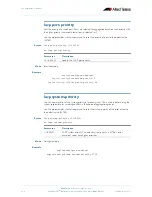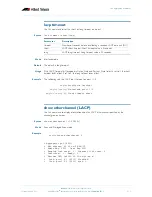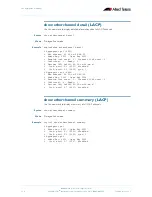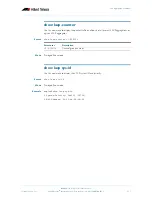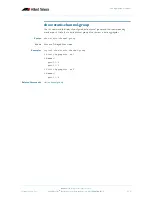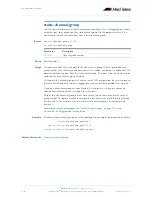
Internet Protocol (IP) Addressing and Protocols
©2008 Allied Telesis Inc. All rights reserved.
22.6
AlliedWare Plus
TM
Operating System Software Reference C613-50003-00 REV E
Software Version 5.2.1
Domain Name System (DNS)
The Domain Name System allows you to access remote systems by entering human-readable
device host names rather than IP addresses. DNS works by creating a mapping between a
device name, such as “www.alliedtelesis.com”, and its IP address. These mappings are held on
DNS servers. The benefits of DNS are that domain names:
■
can map to a new IP address if the host’s IP address changes
■
are easier to remember than an IP address
■
allow organizations to use a domain name hierarchy that is independent of any IP address
assignment
Domain
name parts
Domain names are made up of a hierarchy of two or more name segments. Each segment is
separated by a period. The format of domain names is the same as the host portion of a URL
(Uniform Resource Locator). The first segment from the left is unique to the host, with each
following segment mapping the host in the domain name hierarchy. The segment on the far
right is a top-level domain name shared by many hosts.
Server hierarchy
A network of domain name servers maintains the mappings between domain names and their
IP addresses. This network operates in a hierarchy that is similar to the structure of the domain
names. When a local DNS server cannot resolve your request it sends the request to a higher
level DNS server.
For example, to access the site “alliedtelesis.com”, your PC sends a DNS enquiry to its local
DNS server asking for the IP address matching alliedtelesis.com. If this address is already locally
cached (following its recent use), the DNS server returns the IP address that matches
alliedtelesis.com. If the DNS server does not have this address cached, it forwards the request
upwards through the hierarchy of DNS servers until a DNS server can resolve the mapping.
This means an often-used domain name is resolved quickly, while an uncommon or nonexistent
domain may take longer to resolve or fail.
As well as the hierarchy of domain name servers accessible through the Internet, you can
operate your own DNS server to map to private IP addresses within your network.
DNS client
Your AlliedWare Plus device has a DNS client that is enabled automatically when you add a
DNS server to your device. This client allows you to use domain names instead of IP addresses
when using commands on your device.
To add a DNS server to the list of servers that the device sends DNS queries to, use the
command:
To check the list of servers that the device sends DNS queries to, use the command:
To add a default domain name used to append to DNS requests, use the command:
For example, to use DNS to match hostnames to your internal network “example.net”, use the
command:
awplus(config)#
ip name-server <ip_address>
awplus#
show ip name-server
awplus(config)#
ip domain-name <domain_name>
awplus(config)#
ip domain-name example.net

